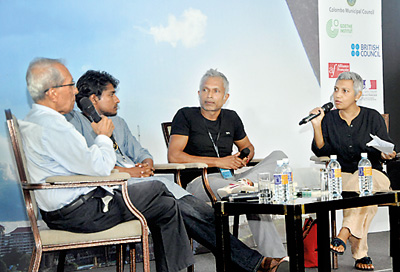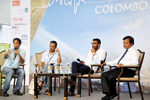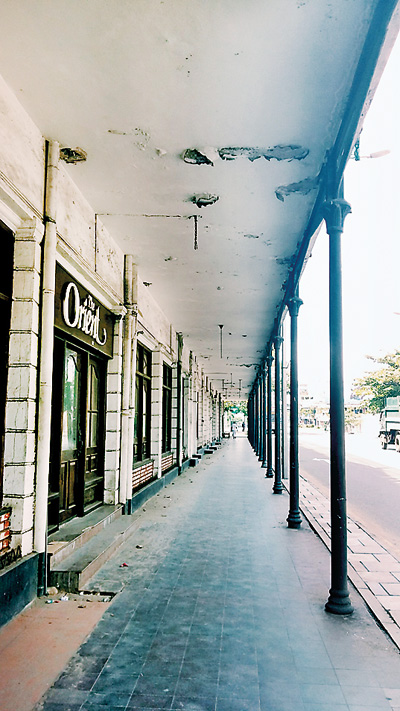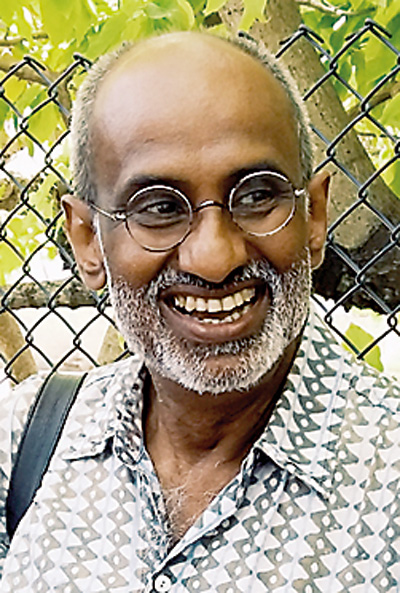Walking, talking, viewing Cinnamon Colomboscope
View(s):Cinnamon Colomboscope unfolded over the weekend of August 22-23, focusing on themes of ‘City. Identity. Urbanity.’ An exhibition ‘Shadow Scenes’ had a multi-faceted collection of artists at the Rio and elsewhere in Slave Island, a programme of panel discussions drew an interested audience. Duvindi Illankoon and Adilah Ismail attended some of the sessions

Colombo Folk: Bradman Weerakoon, Halik Azeez, Ashok Ferrey and Ameena Hussein
The City as a Character: Dystopias, utopias and all that is in between:
At the very end of the panel, a seemingly disappointed audience member piped up that she did not hear the word utopia or dystopia mentioned even once but British-Jamaican-Chinese author Kerry Young and Indian writer and journalist Naresh Fernandes managed to entertain for other reasons. Young did a great reading, fielding questions on life in Kingston town, while Fernandes drew on his long history with Mumbai to talk about life in the city of dreams.

Highlighting humour: Jonathan Coe reads from his book, ‘The Rotters’ Club’. Pic by Indika Handuwala
Both authors saw parallels in the way cities have evolved – commenting on the increasing isolationism of the rich and a deepening class divide. Fernandes made a point of the Ambani residence, a 27-storey tower in Mumbai that is home to only four people but is certified, somewhat ironically, as a green building. Author and former curator of Colomboscope, Ashok Ferrey moderated.
Future Cities: The balancing act:
In one of the most anticipated sessions in the programme that day, lawyer and political commentator Gehan Gunatilleka spoke with architect Madhura Prematilleke, and Chairperson of the Western Regional Megapolis Project Ajitha De Costa and Singaporean architect and urban designer Naomi Hanakata. “There is a certain school of thought that maintains the military did it well, they maintained it well and that is the only way to get things done,” said Prematilleke, who argued for the citizen’s right to own and maintain these public spaces. The frank conversation covered thorny yet pragmatic concerns such as the need for improved public transport.

The panel at Capital Drive: Deshal de Mel, Vijay Nagaraj, Sancheevan Mahendran and Upul Jayasuriya. Pix by Nilan Maligaspe
De Costa highlighted waste management as one of the big challenges facing the development of the Western Region and emphasised a need for sustainable development. In a lengthy Q&A with the audience, De Costa, in particular, was peppered with many questions from an audience very interested in the future of the area.
Singapore as a model for Sri Lanka was addressed, with Hanakata asking who would foot the bill for the proposed megapolis and whether the costs would be passed down to ordinary citizens. De Costa responded with his conviction that government would find the money. He also emphasised that the development would take place over two decades or more and was not a short term project.
Capital Drive
The session questioned if there was a widening gap between Colombo and the rest of Sri Lanka, wondered in what capacity investment has influenced Colombo’s rapid change and examined Pettah’s contribution to the city as a driver of capital. Vijay Nagaraj, a researcher at the Centre for Poverty Analysis, and Chairman of the Board of Investment Sri Lanka Upul Jayasuriya discussed Colombo’s economic revival, equality between investment and labour and the advisability of tax incentives. Pettah businessman Sancheevan Mahendran presented a convincing argument for the formalization of Pettah’s credit-based financial system, noting that the informal system was diminishing at present and adding “the law needs to change-the more formal it becomes the more it will thrive…we need a method to the madness.” Economist Deshal De Mel moderated.
Colombo Folk: Identity and Rootedness in a Changing City
When you seat Deshamanya Bradman Weerakoon in a panel with around 40 curious audience members the conversation is
bound to digress wildly from the topic at hand (author, publisher and moderator for this session Ameena Hussein’s sleight of hand in gently directing the conversation back on track was admirably efficient). Photographer Halik Azeez and author Ashok Ferrey also joined the discussion to examine what makes Colombo folk who they are in the historical and present context.
Forced evictions were a recurring subject-Azeez offered a glimpse into the lives of these evictees with photographs and stories from his walks, noting that these largely low income families were vital to making cities work thanks to the informal labour they provide. When the discussion inevitably arrived at post-war Colombo Ferrey noted-“we’re a nation of storytellers (…) we love to subscribe to myth over reality and because of this we’re unlikely to get anywhere.” Weerakoon concurred-“we’re in denial”- later adding more optimistically “I would like Colombo to not change too fast or too dramatically.” He also questioned as to how one makes a growing city seem familiar, noting humorously that as a city’s people “we’ve become good at rhetoric and bad at implementation.”
Realism, Reportage and Representation
“How do you draw a cartoon of a cartoonish situation?” mused political cartoonist Gihan de Chickera, about Sri Lanka’s unconventional political climate and the art of documenting it as a cartoonist, at the session on realism, reportage and representation. Gihan spoke quietly but eloquently on self-censorship, the need to look beyond mainstream narratives and pushing the glass ceiling through cartoons as a medium. The session which also featured British satirist Jonathan Coe and Indian journalist and editor of Scroll.in, Naresh Fernandes moderated by Smriti Daniel covered interesting themes in modern reportage.
Coe spoke about the culture of satire in Britain and raised issues such as sidestepping around sensitivities and giving offense in satire – “Giving offence is one of the ways to get to the truth”. While Fernandes debated on the vein of sophocracy in India’s politics (India is supposedly the world’s largest democracy but has very underdeveloped liberal institutions), the pernicious nature of market censorship and the curious brand of ‘aspirational journalism’ seen in Indian cities such as Mumbai.
Metro/Sexual
In what was arguably one of the most well attended and enjoyable sessions of the day Tracy Holsinger directed a group of actors, directors, authors and activists as efficiently and effectively as she would a play. Seated around the Rio Pool, attendees watched, laughed and cheered as this group of individuals explored gender and sexuality in Colombo, examining in particular the progress of the LGBTQ movement, even inviting Dr. Dayanath Ranatunga to sit in on a short panel discussion alongside Indu Dharmasena and a representative from Equal Ground for one of the evening’s most important sessions. Apart from this, several short skits tackled gender perception, representation of women in media and sexuality.
Narrating City Lives
French author Eric Reinhardt and British satirist Jonathan Coe discussed the cities in which they based their novels ‘Victoria System’ and ‘The Rotters’ Club’ respectively. Both read from their novels and spoke about the use of humour – and in Coe’s case satire – in their work. Reinhardt cited familiarity for choosing Paris as the backdrop for his novel, a work he described as “a critique of globalization, capitalism and ultra-liberalism.” Coe described The Rotters’ Club (a book that incidentally seems to hold the record for the longest sentence in English literature with a record 13955 words) as somewhat semi-autobiographical, and an “attempt to render in fiction the comedy and action of adolescent life.” Birmingham, where he bases his book, was also the city he grew up in- thus he was able to render a more realistic portrayal of what growing up in that city was like. Reinhardt agreed, noting that it was important for the author to know their characters’ surroundings intimately. Keith Davies moderated.
Cinnamon Colomboscope was organised by EUNIC Sri Lanka–Institut Francaise, the Goethe Institut and the British Coouncil.
 A walk through the past: Asoka de Zoysa and above, the Nippon Hotel walkway. Pix by Adilah Ismail The Slave Island Walk : The metamorphosis Slave Island was slowly waking up when an assorted group assembled at Rio Cinema on a clear, Saturday morning last week. The third edition of Cinnamon Colomboscope explored themes centred on the city, identity and urbanity and it was only apt that an exploration of Slave Island was part of its programme. The festival’s theme was a timely one. Colombo has been struggling to find its post-war identity over the past years and this identity crisis and metropolitan angst has been exacerbated by political webs, class tensions and market forces. Slave Island and its surrounding areas stand as an example of these tensions and a spatial fragment of a tangled city straddling ghosts of its past, present and futures.
From Rio Hotel’s history and its fate in the July 1983 riots, the architecture of the Kompanna Vidiya Railway Station to the urban legends which shroud the history of Castle Hotel and the curious history of the origins of its name– Slave Island’s stories are seemingly endless. These days, the historical landmarks stand a little tentatively in the middle of the building bustle which shrouds this part of Colombo. Tall cranes (of the construction variety) are framed against the skies, their cheerful yellow in stark contrast to the azure blue, looming over the brisk construction which takes place. The old residents of Slave Island are mostly invisible now and their fates still precarious because of the resettlement process undertaken over the previous years as a part of Colombo’s beautification project. In the middle of dust, construction and building bustle stands the Malay Military Mosque – a lone building of resistance. Kew Gardens no longer contains a garden, Nippon Hotel is undergoing a facelift and the Beira Lake is a shadow of what it used to be. It’s hard to reconcile the Beira (now vastly diminished in size and occasionally an olfactory assault to the senses) to what Henry W. Cave described as “one of the most charming features of Colombo”, waxing eloquent about palms, lemon yellow lettuce trees, bamboo, hibiscus which grew on its borders. Like all cities, Colombo has metamorphosed drastically over time –this is only inevitable after all. But in order to build New Colombo, there has been a gradual erasure and diminishing of Old Colombo. The Slave Island walk at Cinnamon Colomboscope was a gentle reminder of this metamorphosis and highlighted the importance of a symbiosis between the old and new, for cities to thrive and survive. -A.I. | |



 The Slave Island walk was conducted by Dr. Asoka de Zoysa – the best way to explore a city, he informed the group before setting off, is by walking or cycling. Navigating past the 162- year-old Christ Church near Galle Face, the Malay Military Mosque, the 114-year-old Victoria Masonic Temple, Nippon Hotel, Castle Hotel and newer buildings, he spoke about Slave Island’s history and offered patient answers to numerous questions augmented by anecdotes and personal histories shared by members of the group. One reminisced about buying his school books and stationery at a now defunct bookshop in Slave Island while another recollected coming for music lessons to popular music teacher, Mary Billimoria Pestonjee at Manning Mansions. Others lapsed into nostalgia remembering the famed Chinese rolls at Nippon hotel and Fountain Café’s hot dogs and one provided a capsule history of the Freemason movement in Sri Lanka.
The Slave Island walk was conducted by Dr. Asoka de Zoysa – the best way to explore a city, he informed the group before setting off, is by walking or cycling. Navigating past the 162- year-old Christ Church near Galle Face, the Malay Military Mosque, the 114-year-old Victoria Masonic Temple, Nippon Hotel, Castle Hotel and newer buildings, he spoke about Slave Island’s history and offered patient answers to numerous questions augmented by anecdotes and personal histories shared by members of the group. One reminisced about buying his school books and stationery at a now defunct bookshop in Slave Island while another recollected coming for music lessons to popular music teacher, Mary Billimoria Pestonjee at Manning Mansions. Others lapsed into nostalgia remembering the famed Chinese rolls at Nippon hotel and Fountain Café’s hot dogs and one provided a capsule history of the Freemason movement in Sri Lanka.